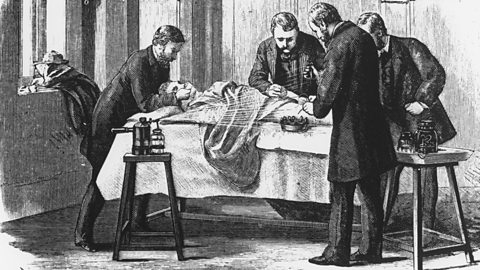Surgery, pain and anaesthetics
Surgery at the start of the 19th century was carried out on patients when they were conscious. Discoveries by Humphry Davy, William Morton and James Simpson meant effective anaestheticA drug that causes loss of feeling or consciousness. were routinely being used by the end of the century.
Surgery in 1800
At the start of the 19th century, there were three key problems with surgery:
- pain
- infection
- blood loss
These issues meant surgery had to be quick. There were also high mortality rateThe number of deaths in a place (or group) compared with the total number of people in that place (or group). as many patients died of infection even if they survived the operation.
Robert Liston was a famous surgeon in the 1840s. He was able to carry out an operation to amputate a leg in under 40 seconds. This was necessary due to the lack of anaesthetics to make sure patients were still, as well as the risk of blood loss if an operation took too long.
“He was six foot two, and operated in a bottle-green coat with wellington boots. He sprung across the blood-stained boards upon his swooning, sweating, strapped-down patient like a duellist, calling, ‘Time me gentlemen, time me!’ to students craning with pocket watches from the iron-railinged galleries. Everyone swore that the first flash of his knife was followed so swiftly by the rasp of saw on bone that sight and sound seemed simultaneous. To free both hands, he would clasp the bloody knife between his teeth.”
Humphrey Davy and nitrous oxide
In 1799, British surgeon Humphry Davy discovered that nitrous oxide worked as an effective local anaesthetic. He gave it the name ‘laughing gas’ and wrote about its potential in surgery. However, it did not become widely used until after Davy had died.
Horace Wells was an American surgeon and used nitrous oxide in a public demonstration to remove a tooth. Unfortunately, the patient wasn’t given enough of the gas. As a result, they made a noise during the procedure, which convinced people it didn’t work.
William Morton and Ether
Horace Wells worked with another surgeon, William Morton. Morton experimented with using ether as an anaesthetic. It worked effectively in preventing patients from feeling pain and quickly became widely used by surgeons in England.
However, there were problems with ether. It was flammable, which meant it needed to be carefully stored. Patients often complained of a sore throat or feeling sick after a procedure when they had been given ether.
James Simpson and Chloroform
James Simpson was a Scottish doctor. In 1847, he and some friends experimented with chloroform. He discovered that it was an effective general anaesthetic. Chloroform replaced ether as the most widely used anaesthetic. The discovery of chloroform meant patients were still during an operation and felt no pain. This meant surgeons could start to consider more complex operations.
Opposition to anaesthetics

There were several reasons people opposed the use of anaesthetics in surgery:
- Some people in the Church argued that pain in childbirth was sent by God, so using anaesthetics for women in labour was interfering with God’s will.
- When not used carefully, anaesthetics could be dangerous. Hannah Greener was a 15-year-old girl who died during a procedure to remove an ingrown toenail because she was given too much chloroform.
- The British army banned the use of chloroform. Some army surgeons argued that patients being awake and in pain helped them to understand how the patient was feeling.
How opposition to anaesthetics was solved
John Snow devised a chloroform inhaler in the 1850s. Before the inhaler, chloroform had been poured onto a cloth and placed over the patient’s mouth and nose. The inhaler made it possible for doctors to control the amount of chloroform a patient was given. This made the use of anaesthetics safer. The inhaler mixed chloroform with water vapour, so the patient could breathe it in.
In 1853, when giving birth to her eighth child, Queen Victoria used chloroform. Her doctor was John Snow and she later spoke of that ‘blessed chloroform’ in easing the pain of childbirth. This gave the public reassurance that chloroform was safe and effective.